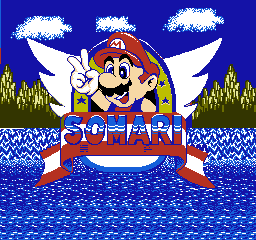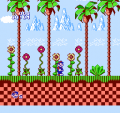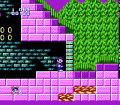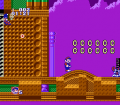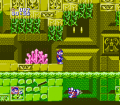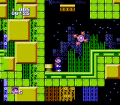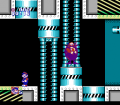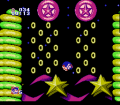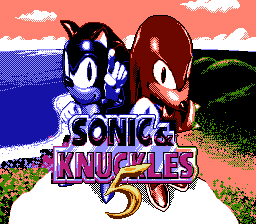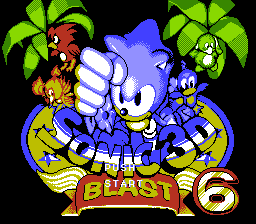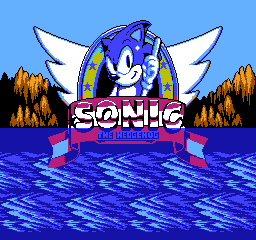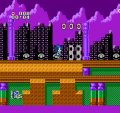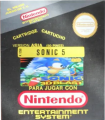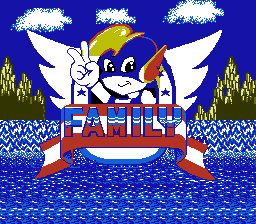Somari
From Sonic Retro
| Somari | ||||||||||||||||||||
|---|---|---|---|---|---|---|---|---|---|---|---|---|---|---|---|---|---|---|---|---|
| System(s): Famicom | ||||||||||||||||||||
| Developer: Hummer Team Co. | ||||||||||||||||||||
| Genre: Action | ||||||||||||||||||||
| Number of players: 1 | ||||||||||||||||||||
|
| |
This short article is in need of work. You can help Sonic Retro by adding to it. |
Somari or Somari the Adventurer is an unlicensed port of Sega's flagship Sega Mega Drive video game Sonic the Hedgehog for the Nintendo Famicom. It was released by Hummer Team in 1994.
Somari is notorious not for featuring Sonic the Hedgehog as its starring character, but Nintendo's mascot Mario, who in this game shares Sonic's abilities.
Contents
Gameplay
Somari is an attempt to bring the original Sonic the Hedgehog to the 8-bit Famicom. Mario (or "Somari") can run and jump like Sonic, spinning into enemies, collecting rings and running around loops, with the spin dash technique included from Sonic the Hedgehog 2 for good measure. The game attempts to mimic the Mega Drive game as closely as possible, though its special stages are based on those found in the 8-bit version of the game (meaning there are no chaos emeralds), presumably due to hardware limitations. Scrap Brain Zone is also missing, though remnants of it exist in the ROM.
There is no ending sequence should the player manage to complete the game - just a single screen showing Dr. Eggman juggling chaos emeralds and some text claiming he will return.
As a very early attempt at getting Sonic to run on simpler hardware, Somari is riddled with issues, from poor collision detection and unresponsive controls to game-breaking glitches. Like many unlicensed titles of its kind, the game is very difficult to play, but is infamous, particularly after being rediscovered on the internet, for its low quality presentation and obvious novelty value.
History
Origins
The true history of Somari is not known, being first spotted by news outlets during the mid-1990s. Cover art seems to suggest a release date of 1994, though whether Somari was the first incarnation of the game is yet to be established.
As with most unlicensed Famicom titles, Somari can be traced back to mainland Asia, being initially spread across Taiwan, Hong Kong and presumably parts of China. It spread into regions that were known from high piracy level of Famicom consoles, that is most of the Asia, Former USSR, Eastern Europe, South America and Africa, though saw very limited distribution in more developed markets due to stricter copyright laws.
In addition to being released as a stand-alone product, Somari was included in many unlicensed Famicom multi-carts, a practise that continues with ever greater numbers of games to this day.
Legacy
Many years later, a hack which improves various aspects of the game was released to attempt to turn Somari into something more playable.
Screenshots
Hidden content
| |
Main article: Somari/Hidden content |
Magazine articles
| |
Main article: Somari/Magazine articles |
Physical scans
| Famicom, RU, 1994 (Steepler) |
|---|
|
|
Multicarts
| Famicom, AS†, 2 in 1, 1997 Super Hik Gold Gard (NT-803) |
|---|
|
|
| Famicom, AS†, 7 in 1 |
|---|
|
|
Variants
Somari has been released multiple times, often modified, under different titles:
Sonic & Knuckles 5
Similar to the above but with a Sonic & Knuckles title screen and theme tune. Sonic is the only playable charater in this game (despite Knuckles is on the title screen). No evidence currently suggests the game was released before 1997.
Physical scans
| Famicom, 1997 (NT 325) |
|---|
|
|
Sonic 3D Blast 6
Similar to above one, but with another different title screen and Marble Zone being set as the first level. This uses the Sonic & Knuckles theme and has an extra "start" screen similar to Sonic 3D. No evidence currently suggests the game was released before 1997.
Physical scans
| Famicom, 1997 (NT 318) |
|---|
|
|
| Famicom, Hi-Game 1999 |
|---|
|
|
Sonic the Hedgehog/Sonic (3D Blast) 5
A version of Somari that changes most of the graphics "back" to Sonic the Hedgehog. The player starts off in Spring Yard Zone rather than in Green Hill Zone, though users have created an IPS file to restore the original level order[2].
The game often refers to itself as Sonic 5 (音速小子5) on packaging. No evidence currently suggests the game was released before 1998.
Physical scans
| Famicom, RU (K&S) |
|---|
|
|
| Famicom, RU (K&S) alt |
|---|
|
|
| Famicom, RU (New Game) |
|---|
|
|
| Famicom, BG (Wen-BC) |
|---|
|
|
Multicarts
Family Kid
A version of Somari for Thai market, promoted by Family TSI Ltd., company known for releasing famiclones brand called "Family", which was very popular in the region. The starting level is Green Hill Zone, just like in Somari.
Physical scans
| Famicom, 2 in 1 |
|---|
|
|
Doraemon
A almost a complete graphical overhaul of Somari featuring the Japanese character Doraemon. It was made by "Waixing Computer Science & Technology Co, Ltd.". It introduces brand new levels and music though gameplay is identical.
Physical scans
| Famicom, TW |
|---|
|
|
| Famicom, TW (970563) |
|---|
|
|
The Hummer
Part of a Super New Year Cart 15 in 1 multi-cart by Hummer Team. It was later insert to a 60 in 1 plug and play from Hummer Team.
Physical scans
| Famicom, Super New Year 15 in 1 |
|---|
|
|
Downloads
|
Download Somari Sonic 3D Blast 5 (131 kB) (info) Super Sonic 5/Sonic & Knuckles 5 (135 kB) (info) Sonic 3D Blast 6 (144 kB) (info) 2-in-1: Family Kid & Aladdin 4 (292 kB) (info)
|
References
| Somari | |
|---|---|
|
Main page | Comparisons | Maps | Hidden content | Magazine articles | Video coverage
| |
|
